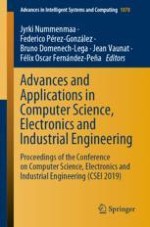2020 | Book
Advances and Applications in Computer Science, Electronics and Industrial Engineering
Proceedings of the Conference on Computer Science, Electronics and Industrial Engineering (CSEI 2019)
Editors: Prof. Jyrki Nummenmaa, Dr. Federico Pérez-González, Dr. Bruno Domenech-Lega, Dr. Jean Vaunat, Dr. Félix Oscar Fernández-Peña
Publisher: Springer International Publishing
Book Series : Advances in Intelligent Systems and Computing
